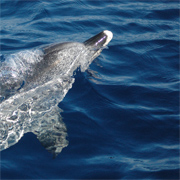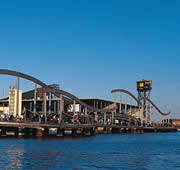High seas gems in the spotlight
09 October 2008 | International news release
Today at the IUCN World Conservation Congress, a joint initiative has been launched to highlight special places in the least protected place on Earth: the high seas. The centerpiece of which is a brochure showcasing 10 “gems” of the high seas.
The publication, launched by an unusual partnership bringing the Chantecaille Beauté company together with IUCN, World Commission on Protected Areas (WCPA), and Marine Conservation Biology Institute (MCBI), features sites such as the Ross Sea in the Southern Ocean, the Emperor Seamount Chain in the Pacific Ocean, the Sargasso Sea and Charlie-Gibbs Fracture Zone in the Atlantic Ocean, and the Saya de Malha Banks in the Indian Ocean.
The 10 sites exemplify the range of habitats in the world’s oceans. “International efforts to identify and protect significant high seas places are in their infancy,” says Jeff Ardron of MCBI. “This booklet should encourage collaborative scientific analysis of high seas ecosystems in need of conservation.”
Currently, less than one percent of our oceans are under any kind of protection, and nearly all of that one percent is located close to shore.
“Unlike national parks on land, most people have never visited these high seas gems, so they have no idea of the richness and staggering beauty of what lies down there,” says Alex Chantecaille, who is Director of Sales Promotion at Chantecaille Beauté and helped oversee this project.
High seas are the open ocean and deep seabed areas outside individual nations’ jurisdiction and make up nearly half of the Earth’s surface and almost two-thirds of the ocean. They provide feeding grounds for great whales, are traversed by imperiled bluefin tunas, and are home to deep-water corals that are thousands of years old.
“Despite the size and importance of the high seas, they are the least protected part of our planet,” says Kristina Gjerde of IUCN. “This brochure is designed to help people see and understand the importance of these remote places to galvanize action at the international level for the first time.”
“The Chantecaille Beauté company has a long history of working towards environmental conservation,” says Sylvie Chantecaille, the owner and founder of the company. “When MCBI and IUCN came to us with their concerns about the high seas, we felt that this was an extraordinary opportunity for us to help these places come alive in the eyes of the public.”
“As the great African conservationist Baba Dioum noted 40 years ago at the IUCN's General Assembly, we will only conserve those places that we know,” says Elliott Norse, MCBI’s President. “We can thank Chantecaille Beauté for helping make these places more widely known, for these are magnificent places that are very much worth saving.”






